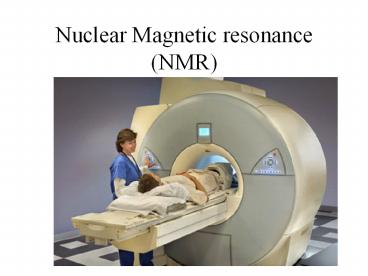Nuclear Magnetic resonance (NMR) - PowerPoint PPT Presentation
1 / 27
Title:
Nuclear Magnetic resonance (NMR)
Description:
Nuclear Magnetic resonance (NMR) Nuclear Magnetic Resonance NMR works by getting hydrogen nuclei in the body to emit radio waves. Analysis of this radiation enables a ... – PowerPoint PPT presentation
Number of Views:710
Avg rating:3.0/5.0
Title: Nuclear Magnetic resonance (NMR)
1
Nuclear Magnetic resonance (NMR)
2
Nuclear Magnetic Resonance
- NMR works by getting hydrogen nuclei in the body
to emit radio waves. Analysis of this radiation
enables a very detailed image to be built.
3
Magnetic nuclei
- Nuclei are charged and spin. This means nuclei
with an odd number of protons or neutrons behave
like mini magnets.
4
Magnetic nuclei
- This means in an applied magnetic field the
nuclei will line up like compass needles but
either with (low energy) or against (high energy)
the field
5
Magnetic nuclei
- The stronger the applied field, the bigger the
difference between the two energy states
6
Resonating
- Just like the compass needle in a field, the
nuclei can oscillate
7
Resonating
- If a hydrogen nuclei is placed in a strong
magnetic field and is pushed by radio waves of
the correct frequency (60 MHz) it will resonate
8
Resonating
- The resonating hydrogen nuclei will emit radio
waves as it resonates, which can be detected and
used to build up an image.
9
Magnetic resonance imaging (MRI)
- The radio waves emitted by the resonating nuclei
are detected by a coil of wire and analysed by a
computer. There are useful aspects of the
radiation that can be used to build the image.
10
MRI - Frequency
- The frequency of the resonance depends on the
strength of the field (stronger field higher
frequency) If the field is varied from one place
to another, the position of the source can be
found.
11
MRI - Frequency
- The frequency of the resonance depends on the
strength of the field (stronger field higher
frequency) If the field is varied from one place
to another, the position of the source can be
found.
Radio transmitter
Radio receiver
12
MRI Relaxation time
- The time taken for the oscillation to die away is
different for different tissue. This can be added
to the image.
13
Use of lasers in medicine
14
Light from a normal bulb
- Spreads out on all directions and is normally
many wavelengths (and phases)
15
Light from a normal bulb
- When focussed by a lens not all light hits the
lens
16
Light from a normal bulb
- The light is not parallel so it is not all
focused on the same point a diffuse spot is
formed
17
Laser light
- The light from a laser IS parallel and consists
of the same wavelength (and in phase). This is
called coherent light.
18
Laser light
- When focussed by a lens, laser light can produce
a very intense point of light
19
Laser light
- Energy from beam can be focused on a very small
piece of matter, causing it to be vaporised.
Cloud of vaporised dog
20
Advantages of cutting with a laser?
- Finer cut
- Vaporising action seals small blood vessels
causing less bleeding
21
Used with optical fibres
- The laser light can be fed along optical fibres
enabling surgeon to performs operations inside
the body without large incisions.
22
Laser angioplasty
- An optical fibre is fed along a blood vessel from
the arm to the heart where it is used to cut away
unwanted material.
23
Measuring oxygen content of blood
24
Pulse oxiometer
- Laser light will pass through thin body parts
like a finger of babys foot
25
Pulse oximeter
- Two lasers are used, one giving out red light and
the other infra red light.
26
Pulse oximeter
- Red light is absorbed most by blood with no
oxygen and IR most by blood with oxygen.
27
Pulse oximeter
- By measuring the relative absorption of the two
wavelengths it is possible to calculate the
amount of oxygen in the blood (as well as
monitoring the pulse.






























